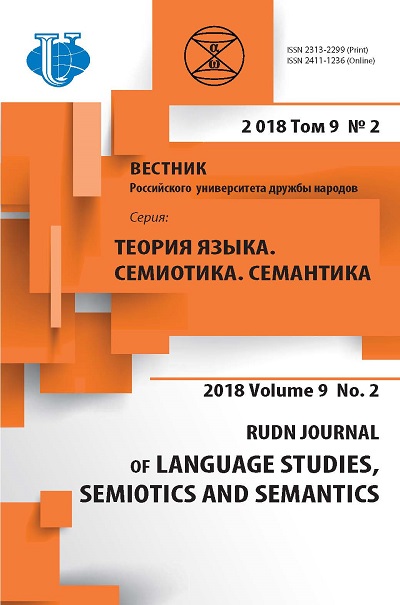CONCENTRATION OF FOREGROUNDING DEVICES IN A POETIC TEXT
- Authors: Dzhusupov N.M.1
-
Affiliations:
- “Syrdariya” University
- Issue: Vol 9, No 2 (2018)
- Pages: 379-387
- Section: Functional and Comparative semantics
- URL: https://journals.rudn.ru/semiotics-semantics/article/view/18750
- DOI: https://doi.org/10.22363/2313-2299-2018-9-2-379-387
- ID: 18750
Cite item
Full Text
Abstract
The article deals with the analysis of foregrounding devices represented in the poetic work “Aytys” by Olzhas Suleymenov. In general, foregrounding as a stylistic phenomenon is typical of all the functional styles. However, it acquires a special importance in the poetic texts which are characterised by a great variety of all-level foregrounding devices and the absence of functional stylistic, emotive, expressive and figurative limits. The foregrounding devices in a poetic context and their distinguishing functional features give the author the opportunity to create non-standard (linguistically deviant) poetic micro text determined by the bilingual artistic thinking. A special attention in the article is given to the analysis of semantic-stylistic groups which include different components providing maximal level of foregrounding in the text: repetition of homogenous syntactic constructions, repetition of lexical units, semantic contrast, violation of rhyme and rhythm, personification, stylistic paradox, etc. The concentration of a great variety of foregrounding devices in the context displays the internal stylistic potentiality of a poetic text in general. The poetic text under analysis is the integration of Kazakh and Russian perceptions of the world which is transmitted by means of the Russian language. The poetic text is characterised by the dominance of the Kazakh mental images, phenomena and objects formed in the mind of a translingual poet. This fact provides the semantic richness of the text and its stylistic potential which is characterised by the author’s individual expressions and the variety of foregrounding devices.
About the authors
Nursultan Mahanbet uly Dzhusupov
“Syrdariya” University
Author for correspondence.
Email: nursultan79@mail.ru
PhD in Philology, Senior Lecturer of the Department of Languages, “Syrdariya” University; Interests: cognitive linguistics, stylistics, cognitive stylistics, comparative linguistics, translation theory, comparative stylistics, German studies
11, M. Auezov str., 160500, Zhetysay, KazakhstanReferences
- Arnold, I.V. (2002). Stylistics. The Modern English Language. Moscow: Flinta: Nauka. (in Russ).
- Kukharenko, V.A. (1988) Text Interpretation. Moscow: Prosveshcheniye. (in Russ).
- Douthwaite, J. (2000). Towards a Linguistic Theory of Foregrounding. Alessandria: Edizioni dell'Orso.
- Leech, G. (1969). A Linguistic Guide to English Poetry. London and New York: Longman.
- Leech, G. (2008). Language in Literature. Style and Foregrounding. Harlow, England: Pearson Longman.
- Leech, G. & Short, M. (2007). Style in fiction: a linguistic introduction to English fictional prose. London: Pearson Education.
- Mukarovsky, J. (1964). Standard Language and Poetic Language. A Prague School Reader on Esthetics, Literary Structure, and Style. Ed. and trans. Paul L. Garvin. Washington, D.C., Georgetown UP, 17—30.
- van Peer, W. (1986). Stylistics and Psychology: investigations of foregrounding. London: Croom Helm.
- van Peer, W., Hakemulder, F. & Zyngier, S. (2007) Lines on Feeling: foregrounding, aesthetics and meaning. Language and Literature. Vol. 16(2), 197—213.
- Suleymenov, O.O. (1976). Feeling the Riverside. Selected verses and poems. Almaty: Zhazushy. (in Russ).
- Dzhusupov, N.M. (2016). Typology of Foregrounding in the English-language and Russian-language Research Papers on Stylistics. In Stylistics Today and Tomorrow. Papers of the 4th International Scientific Conference. Moscow: Faculty of Journalism, 183—186. (in Russ).
- Dzhusupov, M., Markunas, A. & Saparova, K.O. (2006). The Modern Russian Language. Phonostylistics. Poznan: Adam Mickiewicz University. (in Russ).
- Saparova, K.O. (2016). Phonostylistics of the Russian and Uzbek Languages. Tashkent: Uzbekiston. (in Russ).
- Kuznetsov, S.A. (Ed.). (2002). Big Dictionary of the Russian Language. St. Petersburg: Norint. (in Russ).
Supplementary files












